Testing - Both Independent and Personal
& All the Technical stuff
A critical part of a successful product
The story behind the rims, is a desire for a Super Single wheel to use on our personal Overland Travel vehicle.
One would have to ask why would I spend 18 months researching and then finally having the 17 x9" rims specifically made ?
Simply because the other options truly did not suit the application, and there had to be a better solution !....
Fellow adventurer travellers began to ask for our Super Single Wheels but before I marketed them commercially I invested in independent testing under SAE J328 by the Mechanical Testing Laboratory of ROH.
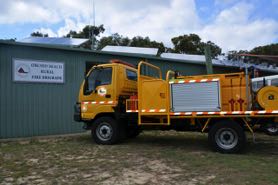
Originally fitted with 19.5s and with 65psi for the rear and 47Psi in the front it is no wonder the Frazer Island Rural Fire Brigade had difficulties driving in the sand.
Tyre Height: 877mm ( 35 inches)
Sidewall Height: 199mm
Wheel Weight: A whopping 80Kg
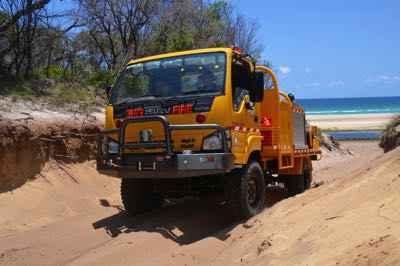
Now fitted with the 17x9's and 37" Hankook Tyres they can drive sand hills like never before !
Tyre Height: 934mm ( 36.8 inches) Sidewall Height 251mm
Wheel Weight: 65Kg
The guys are exceptionally happy.
Fitment to the rear axle.
1. Remove the outer nuts, then the first dual wheel.
2. Remove the cover stud ( with the square end), then
the inner wheel.
3. What remains are the rear wheel studs.
4. These are the same size (but not necessarily the same
part number) as the front wheel studs.
5. You will need a set front wheel nuts to mount the rear
wheels.
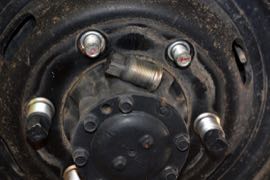
Fuso FG84
The front left entry steps may need knocking forward as the left wheel may touch when cornering. A knock with a sledgehammer will move it forward from the standard 50mm clearance to 80mm.
The wheel flare will either need removing, cutting back at the front or add a wider flair. Rubber ones are available from auto shops. See accessories for our Fuso wheel flair.
When tilting the cab, the wheels will need to be turned full lock left if you have standard springs or straight with after market springs.
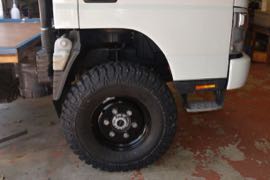
Isuzu NPS
The front steps either need modifying or removing the bottom step all together.
The front mud flaps will need holding back or modifying.
The front rear guards can be moved outwards about 30mm as there are extra holes in the guard to allow for this.
When tilting the cab turn the wheels to the left about half way.
Earlier model NPS may need modification to the air conditioner condenser brackets in front of the LHS wheel.
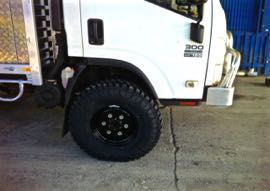
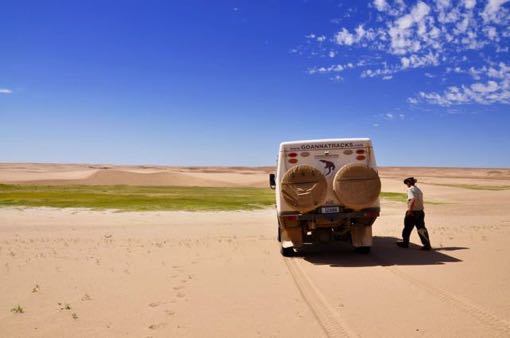
No Road Testing
Gobi Desert
Mongolia
The Fuso/Isuzu rim has been tested at 2180Kg x 2.25 = 4500Kg and ran for 400,000 cycles which is the requirement before testing was stopped.
This test was completed with a Hankook Dynapro MT 37x12.5 R17 - 129Q ( 1850Kg @ 160KPH
Thus at the tested weight of 4100Kg/wheel, this is well within the axle loads.
Isuzu NPS 250/300 Post 2009 - Front 2900 Rear 5600Kg
Isuzu NPS 250/300 Pre 2009 - Front 2600 Rear 4000Kg
Fuso FGB71 - Front 2800 Rear 5760Kg
Fuso FG84 and earlier - Front 2600 Rear 4300Kg
The Iveco rim has been tested at 1950Kg x 2.25 =4,387Kg and ran for 1 Million cycles without failure.
Iveco rim SAE J328 test at 1950Kg
The Iveco Front/Rear axle carrying capacity is 2450/3700Kg thus the wheel can support more than twice the rear axle load
Conformance to the Australian Tyre & Rim Associations Guidelines:
The following documents confirm the rims are manufactured to the tolerances of the Australian Tyre and Rim Associations guidelines for on-road use
All AAV4x4 rims are made with 5mm outer bands and have a 10mm face place.
To our knowledge we are the only manufacturer offering 5mm outers. No manufacturer did so globally so we invested in a rolling mill to do so. Normal LandCruiser type rims use 4mm outers and these were destroyed during early testing and did not pass the fatigue test under SAE J328. Failed SAE testing using 4mm outers
Super Single Advantages:
Changing dual wheels to super singles offers the following advantages.
Why 17x9's ?
Vehicle rims come in two types. .
Type 1 for Cars, SUV's and Light Trucks like the Ford F series, other big American trucks, and the Military and Civilian Hummers.
These are 15", 16", 17" and 18" rims and tyre manufacturers make a vast range of tyres to suit the on and off road requirements of these vehicles.
For a 17" rim the availability of a 37x12.5 or 13.5 R17 tyre both locally and internationally is vast.
Hankook, BFG, Micky Thompson, Yokohama, Cooper, Goodyear, Falken, Federal, and Nitto all offer a 37" tyres.
For Fuso, Isuzu and Iveco vehicles using a 17" rim and a 37" tyre the distance between the rim and the outer diameter of the tyre, ( the side wall height, in this case 10 inches or 252mm ) offers a far better ride and a massive footprint on deflation in sand or mud.
Comments on Super Singles available:
Iveco 16 x 6.5” mounted with Michelin XZL’s 255 100R 16’s.
These are the Iveco factory fitment option for the Iveco Daily 4x4 and is also a discontinued option previously available for Fuso and Isuzu vehicles.
These are a great tyre, we used them across Australian deserts, on the Road of Bones in Siberia and for our travels Vladivostok to London.
There are a number of issues using the Michelins:
Tyre Pressure:
How a tyre performs, the vehicle's ride and tyre longevity all depends on the pressure.
You will need to know the actual axle weight ( curb weight) as measured on the front and rear axle. This is NOT the axle load as per the vehicle specifications but the actual load in your vehicles normal configuration.
Use this Rim and Tyre Pressure Calculator and fill in the yellow spaces and it self calculates a guide for tyre pressures for on-road, off road and sandy conditions.
Odometer/Speedometer:
With larger diameter wheels for Fuso and Isuzu vehicles you will need to adjust your speedometer/odometer.
On an Iveco the speedo is pre-set for the 255x100R16's which are the same diameter as the 37's
Iveco 55S17W
With the 37” Hankook tyres the Iveco Odometer now reads accurately.
As the 37x12.5 R17 tyre is slightly wider than the factory original, the Iveco diff lock mechanism above the spare tyre needs to be moved up on the chassis by 20 mm. Instructions
Fuso FG649 and earlier models
The air conditioner condenser in front of the front left wheel may need moving or modifying.
The front left entry steps may need knocking forward as the left wheel may touch when cornering. A knock with a sledgehammer will move it forward from the standard 50mm clearance to 80mm.
The wheels will need to be straight when tilting the cab.
Vehicle modifications that I am aware of:
Should the springs have sagged and almost on the bump stop, then consider a spring upgrade.
Fitment:
Fuso & Isuzu rims have two valve holes allowing easy access to adjust tyre pressure when mounted face out (front) or reversed (rear). A normal straight fitting on the outside and a 90-degree valve stem on the inner side allows this valve stem to clear the internal front brake hub.
Removal of dual wheels and fitment of Super Singles may or may not be road legal and fitment of them is at the owner's discretion.
These rims are structurally sound, and apart from the independent load tests detailed above, I have driven over 200,000Kms across the Gobi Deserts (sand), Alaskan Ice roads (rocks), and the notorious Brazilian BR319 through the back end of the Amazon (mud), and the very dry sandy river beds of Namibia.
All without issues. Average tyre life has been 60,000Kms without the use of a spare. My vehicle weights an average of 5000 to 5500Kg.
For all Fuso and Isuzu vehicle fitment ideally requires a set of front wheel nuts to be used on the rear wheels. These would be available from Fuso, Isuzu or a truck wrecker. We also stock then for your convirnence.
Iveco 17x9” Steel Wheels
There are some new 17x9” wheels on the market but with only a 4mm outer band. In our initial development we tested a 4mm outer and the outer band failed with catastrophic consequences. This is a copy of our SAE J328 test back in 2012 with a 4mm outer band. ROH Failed SAE J328 with 4mm outer
I note these are not supplied with an independent SAE J328 radial fatigue report but one from China !
Furthermore the off set is such that to be fitted legally one must add wheel arch flares.
AAV4x4 17 x 9” mounted with a 37x12.5 R17
I found these an excellent all round tyre/rim combination. They are great off-road, giving good positive direction and feel. Airing down for sand gives a massive foot print.
The big plus is the replacement tyre price (around A$480 in Aust) and the availability internationally of many other 37x12.5 R17 tyres
I now have 1000’s globally without a single issue.
Tyre Height: 934 mm ( 36.8 inches)
Sidewall Height: 251mm
Wheel Weight: 66Kg
19.5 x 8.25” mounted with Toyo M608Z 285/R70/19.5
These are extremely heavy duty 16ply tubeless tyres for semi trailers. As quoted from the Toyo site "The M608 is a dependable drive tyre designed for regional and urban pickup and delivery service" .
Because they have such a strong side wall, airing them down for off road use is useless. To get a reasonable footprint they must be aired down so far that one is likely to break the bead.
On road, the suggested travelling pressure (120psi) is so high that the vehicle rides like a concrete truck.
With such a strong side wall reducing to 80psi achieves little.
Here are the suggested running pressures from the 19.5" rim supplier.
Rim Testing Under SAE J328 or J267:
This SAE is the minimum international performance standard for fatigue testing of wheels for passenger cars, light trucks, and multipurpose vehicles.
The SAE J328 test is carried out in two parts:
A Dynamic Cornering Fatigue Test of 18,000 cycles where there will be no evidence of failure, as indicated by propagation of cracks, new visible cracks penetrating through a section, or the inability of the wheel to sustain a load.
A Dynamic Radial Fatigue Test of 400,000 cycles where there will be no evidence of failure, as indicated by propagation of cracks, new visible cracks penetrating through a section, or the inability of the wheel to sustain a load.
The Load for the SAE J328 test is a massive 2.25 times the stated load capacity..
Maybe that is why no other Super Single rim supplier supplies such a test report from an Australia
• Significant improvement in off-road ability particularly in sand and mud.
• Eliminating the problem of rocks caught between the rear dual wheels
• Changing/checking tyre pressure reduced to 4 and not 6 tyres.
• Only one spare is needed
Changing the tyre size from 32” to 37” offers the following advantages.
• Improved ground clearance. ( Diff height change + 50mm )
• Improved approach, departure and ramp over angle.
• 14% lower engine RPM
An Isuzu NPS at 95KPH ( GPS Reading) is 2400RPM after fitment is 2050RPM =14.6%
A Fuso Canter at 95PKH ( GPS Reading) is 2650RPM after fitment is 2300RPM = 13.3%
. Less in cab engine noise at the same speed
. Improved fuel economy, as bigger rolling diameter.
. The torque of the vehicles is very capable to handle the larger size with ease.
. The ride is significantly improved.
On-road tyre pressure is recommended at 45/60 Psi unlike the OEM wheels at 80 Psi, or the Toyo's on 19.5 rims at 80/120Psi
The Hankook Dynapro, Gladiator AT's or MT's and Federal Xplora are all flotation tyres, that bulge when deflated, giving a massive footprint for sand driving ( 20-22 Psi )
Type 2 rims are for Heavy Transport, these are 17.5", 19.5" and 22.5". The tyres that are manufactured for these rims are designed for extremely heavy loads and generally black top driving.
For this reason the recommended tyre operating pressures are high and in the region of 100psi plus. The side walls of such tyres are extremely strong and give almost no flex and regardless of lowering the pressure the ride is still as if your were in a concrete truck !
Using for example a 19.5" rim and say a Toyo 285/70R 19.5 M608Z. The rim diameter is 19.5" and the tyre diameter is 35.4". Hence the side wall height is only 7.95" or 200mm. With such a strong construction and high pressure there is little or no flex. This all equals a hard ride and little off-road ability.
• The cost is near A$ 1000 in Australia (US$810 in the US), the second is the availability.
• They are very rare. The supply is difficult in Australia and impossible in many other overseas
countries.
• The best we attained from our two set of 4 was 35,000 and 40,000 Kms, which made running costs extremely high.
• There is no other alternative tyre globally that fits a 16x6.5” rim.
• The Michelins are speed rated to 100KPH, not ideal for highway driving.
• On road noise is high and difficult to have an in-cab discussion
• Over 80KPH on the black top they heel and toe significantly, require constant rotation and with the increase in heel and toe the noise level increases.
FOR EARLER MODEL FUOS & ISUZU
AAV offer a Speedo re-calibration unit that easily fite ion tomspeedo cable under the vehicle
Recent testing has now taken the rim to 2300KG to accommodate for the higher load 37x12.5 R17 rated at 137N ( 2300Kg @160KPH) and is appropriate up to a 7,000Kg GVM vehicle.
FOR THE NEWER MODEL FUSO, ISUZU & HINO
The manufacturers workshop can adjust the odometer/speedometer simply by logging into to the vehicles computer. Cost around $150.
Compliance:
AAV4x4 now has compliance for Super singles for the following vehicles:
* Fuso FG637, FG649 - APPROVED as a modification
* Fuso FG84 2009 to 2010 - APPROVED as a modification
* Fuso FGB71 2011 to Current - APPROVED both as an SSM for NEW vehicles and a modification plate
* Isuzu NPS 250/300 2000 to 2016 Pre ABS - APPROVED both as a modification plate for previously registered vehicles.
* Isuzu NPS 250/300 2017 to Current APPROVED both as an SSM for NEW vehicles and a modification plate
* Hino 817 4x4 2017 to Current - APPROVED for both SSM for NEW vehicles and a modification plate for previously registered vehicles.
Personally I am not in favour of alloy rims for off-road use. Under hard knocks alloys crack - steel bends.
Yes they use them for off-road racing BUT they have support crews to carry spares !
Yes the rims are lighter but when the heaver tyre the weight is a massive 72Kg - that is 6Kg heavier than our production 17x9" steel rims with a 37" tyre
Alloy Wheels 17" and 19.5"
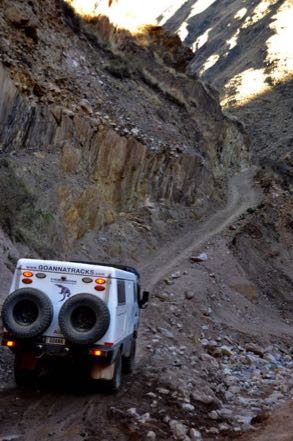
Mountain Road
4300m Andes Mts
Peru Sth America
